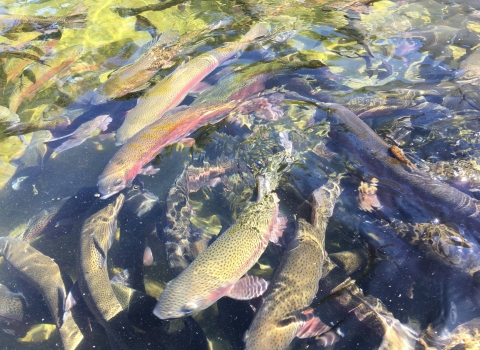AVALON, CA -- For the first time since intensive restoration efforts began nearly 30 years ago, two bald eagle chicks have hatched unaided by humans on Catalina over the weekend. Biologists have been working diligently to reestablish breeding bald eagles on Catalina after they disappeared from the region because of DDT contamination and other human impacts.
The parents are long-time residents of the island. The 21-year-old male, originally from British Columbia, was released on Catalina in 1986. The 8-year-old female was hatched at the San Francisco Zoos Avian Conservation Center, and released from a hacking tower on the in 1999.
Bald eagle restoration efforts on Catalina began in 1980 when the Institute for Wildlife Studies (IWS), in cooperation with the U.S. Fish and Wildlife Service, the California Department of Fish and Game, and the Catalina Conservancy, began a reintroduction program. Eagles disappeared from the Channel Islands by the early 1960s likely due to the hundreds of tons of DDT waste products released into the ocean south of Los Angeles that caused the birds to lay thin-shelled eggs.
From 1980 to 1986, 33 bald eagles were released onto Catalina in an effort to reestablish the species on the island. Some of these birds matured and formed breeding pairs. In 1987, the first eggs laid by the reintroduced birds broke. Analyses revealed that high DDT contaminant levels likely caused the failures. The DDT and associated waste products that remained in the environment were still affecting bald eagle reproduction.
In 1989, biologists began intensive efforts to help sustain the reintroduced population, since the birds could not do so on their own. Biologists climb into the nests and carefully replace real eggs with fake ones. The eggs are then brought back to an incubation facility. If chicks hatch, they are fostered back into nests. If too few hatch, captive-born chicks from the San Francisco Zoo are fostered into the nests. Since 1980, more than100 bald eagles have been released or fostered into nests on Catalina Island.
"After watching nests fail over the last 19 years, it is tremendously rewarding to see them hatch on their own," said Dave Garcelon, President of the Institute for Wildlife Studies, the non-profit group that conducts on-the-ground restoration. "Despite all that time, we never gave up. Our perseverance has paid off and we can finally celebrate this monumental event!"
Nests established as part of a separate but related IWS bald eagle restoration effort on the Northern Channel Islands have also had some breeding success. Last year, two chicks hatched and fledged successfully on Santa Cruz with no human intervention. IWS biologists are also carefully monitoring two eggs that have been laid this year.
Funded through the Montrose Settlements Restoration Program, a multi-agency effort to restore resources injured by the past releases of DDTs and other contaminants, the goal of the Northern Channel Islands program is to establish birds on some of the Channel Islands that are farther from the source of contamination where their chance of successful breeding may be higher.
"It is a testament to the persistent legacy of DDTs that now, over 50 years later-- half a century!--we are just beginning to see successful natural reproduction by bald eagles on the Channel Islands," says Annie Little, a wildlife biologist for the U.S. Fish and Wildlife Service who works with the Montrose Settlements Restoration Program. "Biologists will continue to monitor these nests, but the successes on Catalina and Santa Cruz bring hope for bald eagle restoration on the Channel Islands as a whole."
The Institute for Wildlife Studies is a non-profit organization dedicated to the conservation of wildlife species, habitats, and diversities, and conducts conservation projects around the world. IWS has conducted bald eagle restoration on Catalina for over 25 years, as well as efforts on the northern islands of the Channel Islands National Park.
The Santa Catalina Conservancy was formed in 1972 to preserve and protect the native plants and animals, and biotic communities of Santa Catalina Island. The mission of the Catalina Conservancy, which cares for 88 percent of the island, is to be a responsible steward of its lands through a balance of conservation, education and recreation.
The mission of the San Francisco Zoo is to connect people with wildlife, inspire caring for nature and advance conservation action. The Zoos Bald Eagle Recovery Program, in conjunction with the Institute for Wildlife Studies, has successfully hatched and released chicks to the wild since 1991, many of which were released as part of the Catalina bald eagle restoration program.
The U.S. Fish and Wildlife Service is the principal Federal agency responsible for conserving, protecting and enhancing fish, wildlife and plants and their habitats for the continuing benefit of the American people. The Service manages the 95-million-acre National Wildlife Refuge System, which encompasses 545 national wildlife refuges, thousands of small wetlands and other special management areas. It also operates 69 national fish hatcheries, 63 fishery resources offices and 81 ecological services field stations. The agency enforces Federal wildlife laws, administers the Endangered Species Act, manages migratory bird populations, restores nationally significant fisheries, conserves and restores wildlife habitat such as wetlands, and helps foreign and Native American Tribal governments with their conservation efforts.


